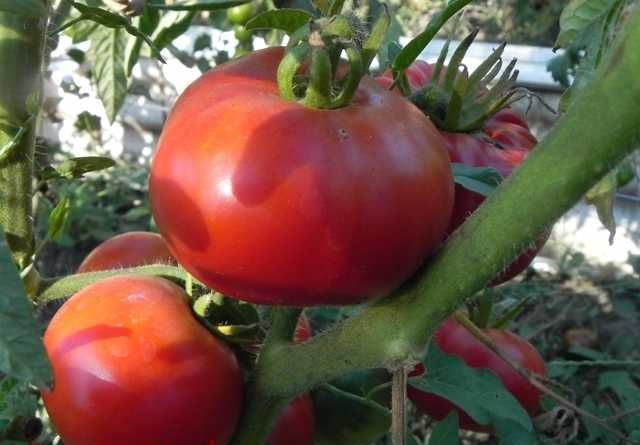 The Brazilian giant variety fully justifies its name. The fruits of this beauty reach almost one kilogram, but you will have to provide the plant with good care. Large-fruited tomatoes in many Russian regions (not counting the south) are grown mainly in greenhouses, and the results are very good.
The Brazilian giant variety fully justifies its name. The fruits of this beauty reach almost one kilogram, but you will have to provide the plant with good care. Large-fruited tomatoes in many Russian regions (not counting the south) are grown mainly in greenhouses, and the results are very good.
Content
Grade description
In the group of collection tomatoes with giant fruits, one cannot ignore the variety Brazilian giant. The name indicates the origin of the tomato, and it was bred by Brazilian breeders and at the same time, on the size of the fruit.
The plants are tall, reaching two meters; when grown in a greenhouse, it can be even higher (up to 210-220 cm). A very powerful variety with good leafiness. The ripening tomato is mid-season, the first fruits are removed after 115-120 days.
It is recommended to grow in shelters, suitable film, polycarbonate greenhouses. In the open ground, the heat-loving culture will yield a good harvest only in the southern regions, therefore it is better not to risk it.
The variety needs regular and plentiful watering, while drying the soil is not allowed. This can affect the quality of the fruit that will crack. A powerful and tall plant needs to be formed, garter. The best results are obtained when the bush is kept in one stem, but it is permissible to leave one stepson for the second stem. In this case, the fruits on the hands will be less, but in general, the yield from one plant will increase.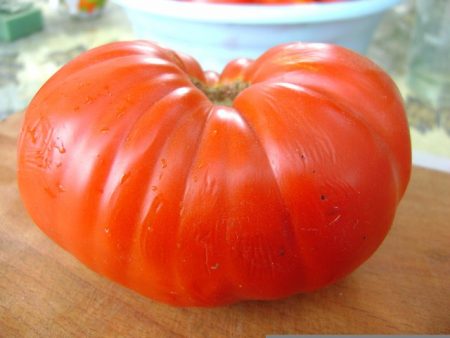
Fruit characterization
Those who cultivated the Brazilian giant tomato note that they chose it precisely because of their large-fruited. Subject to the rules of agricultural technology, it is possible to obtain very large fruits by weight, up to 800-100 grams.
Tomatoes have a rounded, slightly flattened shape, dense but thin skin. The color is bright red, the flesh on the cut is raspberry-dark.
The fruits are fleshy, very juicy. The taste is excellent, and sweetness and a slight acidity are harmoniously combined, and all gardeners converge in this. The pulp is sugary, has a barely audible aroma. The use of tomatoes mainly for salads, also the fruits of the Brazilian giant are suitable for making juice, pasta, sauces.
This variety belongs to beef tomatoes, and as you know, their fruits are special - tender, fleshy, with high nutritional value.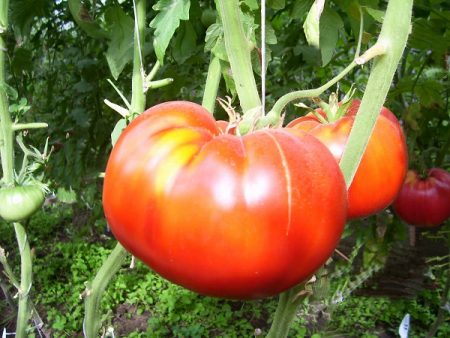
Advantages and disadvantages of the Brazilian giant
The main "plus" of this variety is large fruits, for which summer residents grow it. It is perfect for cultivation in closed ground conditions, as it evenly fills the entire space of the greenhouse.
The following properties also belong to the advantages of the variety:
- optimal fruit ripening dates (in a state of technical ripeness, tomatoes can be removed from the Giant after 115 days);
- excellent taste of the fruit;
- the ability to grow a variety even in conditions of risky farming regions (but only in greenhouses);
- disease resistance.
The seeds of this tomato are prescribed by collectors, they are not on sale in stores. And since this is a variety, not a hybrid, you can always get your seeds and grow tomato from them if you wish.
Thanks to the juiciness of the fruits, the Brazilian giant is perfect for a variety of culinary preparations. Such tomatoes make excellent sauces, ketchups, juices, dressings.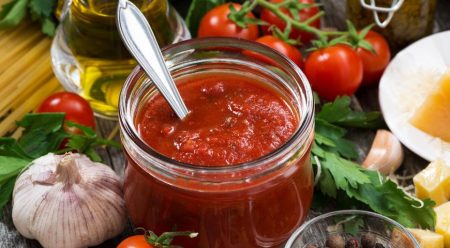
"Cons" varieties:
- the need for mandatory bush formation;
- stepchildren;
- conducting enhanced dressing;
- the fruits of this tomato can turn out to be slightly clumsy (if some agricultural practices were violated);
- tomatoes with irregular watering may crack.
Plant formation is a technique that is used for most indeterminate varieties and hybrids, and gardeners should take this into account. You can get the yields declared in the descriptions, large tomatoes only if you have some experience in growing a crop, if you have the time to carry out planting, systematic watering, and not throw the tomato to the mercy of fate.
Pay attention to the tomatoes, provide them with full care, and you will truly have a Brazilian giant.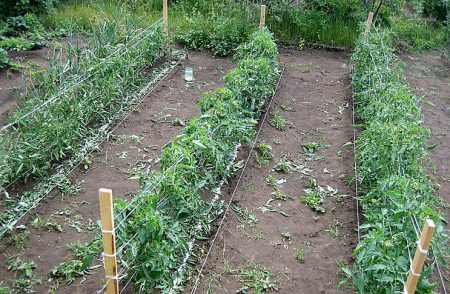
Tomato Growing Reviews Brazilian Giant
Olga, Ryazan region
Seeds for the first time bought from a collector. I liked the description and especially the fact that the fruit of the Brazilian giant variety should have red skin and raspberry flesh. Grew in my polycarbonate greenhouse, led it into two stems. But this is only the first year, in the second, already from experience, left only one stem. Tomatoes weighed an average of 700-750 grams, delicious. But there was no raspberry pulp, and on top and inside were red.
There were a lot of sloppy tomatoes, but this was not reflected in the taste. Fruited almost until the end of September, there were 3 fruits in the hand. I grew three bushes, I took 18 fruits from one, and 16 and 15 from the other. The variety is prone to cracking, but it is not critical for me. I’ve been growing it for the third year now, I am happy with such a tomato.
Angelina, Vitebsk
She received seeds from this tomato from a neighbor, and she received it through her fifth hands from an amateur who collects different varieties. Grown in a greenhouse, I liked the variety very much - both in taste and in size. The Brazilian giant is demanding on watering, otherwise it will crack. My first tomatoes were like that, but then I quickly straightened out the schedule, and the following brushes were all beautiful, large. Weight - about 800 grams - two tomatoes, the rest within 500-600 grams. The color is orange-red, but more red.
Features of growing tomato Brazilian giant
Indeterminate tomatoes require special care, but this is all offset by excellent results. Unlike low varieties, indets have higher yields, in addition, they differ in an extended fruiting period.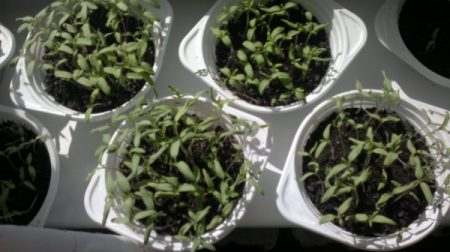
Growing seedlings
The age of seedlings when planting in shelters should be about 60 days. Based on these terms, they calculate the time of sowing seeds for seedlings, and usually this is the beginning of March.
Seeds need preliminary preparation:
- disinfection (use garlic infusion, potassium permanganate);
- soaking in special growth stimulants (you can use aloe juice diluted in water for this, as well as ready-made compositions of Epin, Energen, Zircon);
- sprouting.
Sown in prepared soil mixture - in common boxes, containers, individual cups. It is advisable to first use small containers for a more uniform growth and proper formation of the plant root system, and then dive (from common boxes into separate glasses), or transshipment.
Twice during the period of growing seedlings, it needs to be fed.
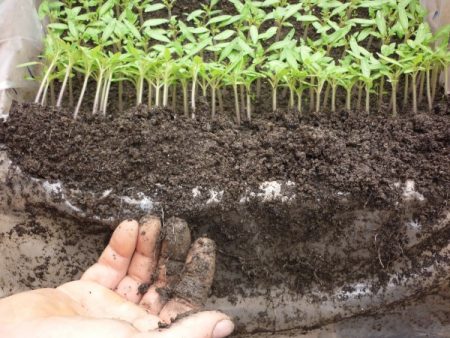
For seedlings, it is better to use complex fertilizers, ready-made compositions for nightshade.A Brazilian giant is planted in a greenhouse only when stable warm weather is established, while the temperature of the soil should be at least + 16ºC (depth 10 cm)
Tomato Care
Three seedlings are planted on one square meter, this will provide the tomatoes with space. Equip the greenhouse with supports for trellises in advance or install stakes for garter on each plant. You need to tie up not only the stem, but also individual tomato brushes so that they do not break under the weight of tomatoes.
When planting, it is advisable to add fertilizer to the wells to provide tomatoes for the first time with full nutrition.
In the future, watering is carried out regularly, given the weather conditions and the condition of the plants themselves. Tomatoes do not need frequent watering, optimally - twice a week (taking into account the weather). If there is heat, then water more often, but make sure that the soil under the tomatoes is well moistened, and the humidity indicators in the greenhouse are not exceeded.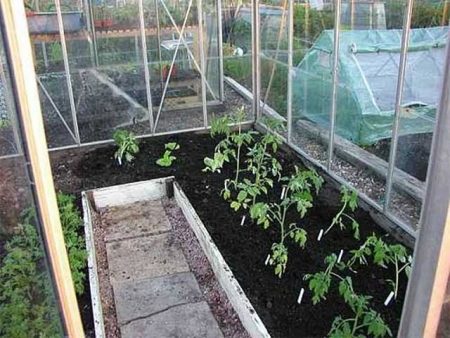
You can not water on bushes of tomatoes, this leads to the appearance of diseases, lower yields. When growing large-fruited varieties, watering is of particular importance, and in this case, the drip irrigation system equipment will be the best option. Water will evenly flow to the roots of the plants, drought and excessive moisture are excluded, the fruits will not crack. Such systems are very convenient even if summer residents visit the site only on weekends, and it is not possible to adjust watering.
Indets form the first flower brush usually after 8-9 leaves, and after 115-120 days it will be possible to remove the first fruits. It should be noted that the brushes of such tomatoes need to be formed, and in order to get tomatoes of large mass, no more than two fruits are left in the brush.
Bush formation
The best option for growing a Brazilian giant is to drive the plant in one trunk, removing all side branches and stepsons. Why is this done?
- Stepsons take on a large amount of nutrients, which leads to a decrease in the number of flower brushes, lower yields.
- A large number of leaves are formed on the lateral branches, which not only “take” food, but also create a dense crown of the bush. This interferes with air circulation, humidity rises in the greenhouse, tomatoes begin to hurt.

If you want to get a large tomato, leave one or two flowers in the brush. The lower leaves of the plant are also removed, but not immediately, but gradually. By the time the fruits are formed on the first flower brush, there should be no leaves at the bottom of the bush.
For support, trellis, a special agri-net or ordinary stakes with fabric ribbons are used. It is not recommended to use twine for garter, as wounds form on it from branches and the trunk of a tomato (the rope cuts into the tissue of the plant).
Feeding large-fruited tomatoes
Experienced gardeners know that such varieties need not only proper formation, but also enhanced nutrition. No top dressing, and in the season they need to be done at least 3-4 times, not get large tomatoes, since the plant simply does not have enough strength to form giant fruit.
As fertilizers use:
- mullein, bird droppings (be sure to breed in water, observing the proportions, otherwise you can get a burn of the tomato root system);
- complex fertilizers (nitrophosphate);
- various ready-made compounds, which are intended for feeding tomatoes in different periods of vegetation (KEMIRA, IDEAL, AGRICOLA);
- infusions of ash;
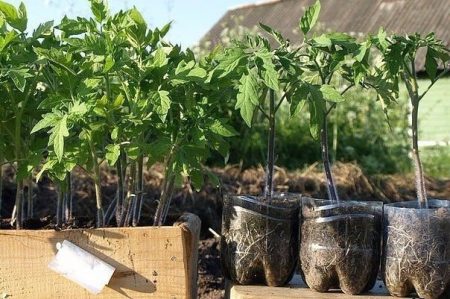
- baker's yeast (diluted in water, used no more than twice a summer);
- green infusions of herbs (nettle, comfrey, dandelion);
- mineral fertilizers.
The first top dressing is carried out no earlier than 15-18 days after planting tomatoes. Subsequent - after 10-12 days, but at the same time it is necessary to take into account the condition of the plants themselves.At the beginning of the growing season, tomatoes need nitrogen, during the flowering period, the formation of fruits, the proportion of nitrogen is reduced, and the portion of potassium and phosphorus is increased.
It is impossible to make too large doses of nitrogen fertilizers, because from this plant “fatten”, there is a powerful growth of vegetative aboveground mass to the detriment of the fruits.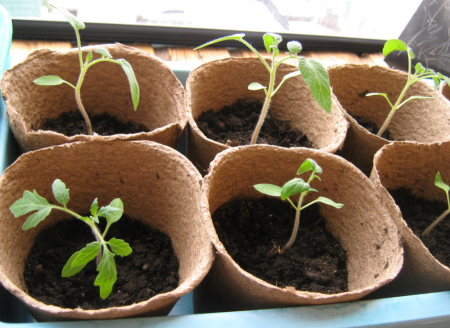
The Brazilian giant is mainly resistant to various diseases. But for prevention, it will not be superfluous to treat plants with copper-containing preparations, Bordeaux liquid. Typically, gardeners in preventive measures use natural compounds - herbal infusions, garlic, which are both effective and non-toxic.
To obtain large fruits, it is recommended to leave several brushes on the stem (for example, 3-5), and remove the rest. In August, pinch the main stem, thereby giving the plant the opportunity to "throw" all the strength and nutrition on the existing flower brushes.
Cleaning
The fruits are usually removed in a state of technical ripeness so that they ripen at home. But it all depends on the gardener himself, as some prefer to ripen the tomatoes, and others it is important that the fruits ripen directly on the bushes. If the weather permits, you can do so, but if it gets cool, it is better to collect tomatoes and put them in a box or box for ripening.
The Brazilian giant cultivar, despite the fact that it was bred far from Russia, has successfully adapted to new conditions and will certainly appreciate a good harvest when it leaves.




 Low-growing tomatoes, without pinching: 5 of the most delicious varieties
Low-growing tomatoes, without pinching: 5 of the most delicious varieties Why tomato seedlings grow poorly
Why tomato seedlings grow poorly We grow a tomato in a shell
We grow a tomato in a shell Growing tomatoes without watering according to the method of Kazarin
Growing tomatoes without watering according to the method of Kazarin